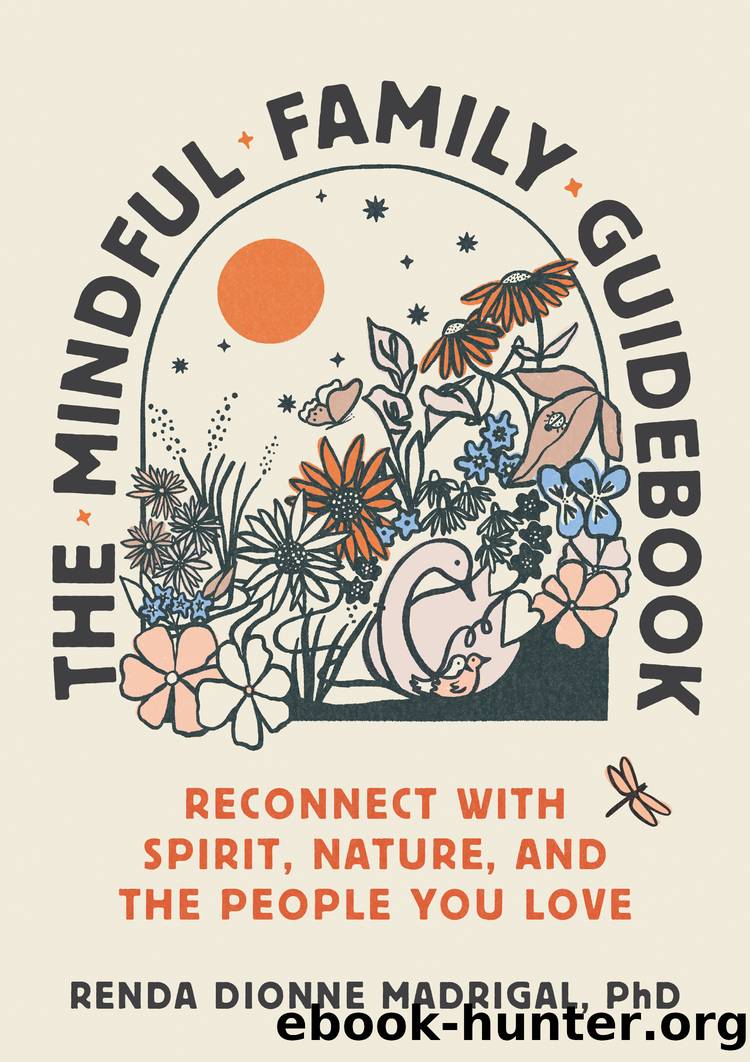The Mindful Family Guidebook by Renda Dionne Madrigal

Author:Renda Dionne Madrigal [Dionne Madrigal, Renda]
Language: eng
Format: epub
Publisher: Parallax Press
Published: 2021-05-18T00:00:00+00:00
* * *
â¦
Congratulations, you have completed Stage 3 of the mindful family journey: Cultivating Family Joy.
CHAPTER 5
MINDFUL FAMILY MEALS
One of the very nicest things about life is the way we must regularly stop whatever it is that we are doing and devote our attention to eating.
âLuciano Pavarotti
Sharing mindful family meals is a practice of reclaiming sovereignty in our lives through listening to our bodyâs wisdom and freeing ourselves from following the unhealthy dictates of artificial society regarding the food we eat. It is a practice that we can use to strengthen our intuitive way of knowing, improve our health, strengthen family bonds, and transmit mindful family values.
With artificial society comes artificial food that is literally killing us. The standard American diet, with processed foods high in sugar, salt, and fat made from genetically modified ingredients laden with pesticides is vastly different from the foods that sustained people for thousands of years. Dr. David Katz from Yale Universityâs Prevention Research Center states that a diet of minimally processed food, predominantly plants, is associated with health promotion and disease prevention; yet in 2015, the American Journal of Clinical Nutrition reported that 61 percent of the foods that Americans buy are highly processed (Poti et. al). As a result, our society has high rates of health problems like heart disease, stroke, and diabetes, even among children.
Chocolate is the food that bears ancient wisdom. Chocolate is often linked with the Swiss, but it is actually an indigenous food from this continent. It comes from a bean that was cultivated by the Olmec Indians and later the Mayans. It was so revered that Cortez became aware of this delicacy through a chocolate honoring celebration he witnessed among the Indigenous people of Mesoamerica.
After he experienced chocolate in the form of a drink, he took it back to Spain where it became a drink reserved for royalty. It was laborious to make, so the Spanish developed a slave trade to cultivate the cocoa bean and make it profitable. Eventually, the Swiss took it and added milk and other ingredients. When it became available to the masses, it was cut with other ingredients until it stopped being primarily chocolate and became another processed food.
Recently, studies have found that real chocolate may lower cholesterol and reduce the risk of cardiovascular disease. Youâll be happy to know that scientists at Harvard Medical School report that drinking two cups of hot chocolate a day may keep the brain healthy and prevent memory decline in older people. But only if itâs chocolate that is similar to its original form, which is impossible to find in our modern world.
Today, dark chocolate is the closest we get to the original Olmec chocolate. As chocolate was modified further and further from its original form, it was developed into something we still call chocolate, but this artificial or processed chocolate lost many of its health benefits. Rather than being a food that helps, now it is a food that puts our bodies at risk.
Download
This site does not store any files on its server. We only index and link to content provided by other sites. Please contact the content providers to delete copyright contents if any and email us, we'll remove relevant links or contents immediately.
Letter to My Daughter by Maya Angelou(1672)
Dog Training 101 by Kyra Sundance(1504)
The Whole Lesbian Sex Book by Felice Newman(1376)
The Pizza Party by Theo Baker(1316)
The Unofficial Guide to Walt Disney World with Kids 2017 by Bob Sehlinger(1206)
Art Lab for Little Kids (Lab Series) by Susan Schwake(1165)
Talking with Your Toddler by Teresa Laikko(1078)
Playful Parenting by Cohen Lawrence J(1072)
Encyclopedia of Infant and Toddler Activities by Kathy Charner(1058)
Circus by unknow(1050)
The Budding Chef by Kate Kuhn(1046)
Welding for Dummies by Welding(1018)
The Big Book of Nature Activities by Jacob Rodenburg(996)
Zen Mind, Beginners Mind by Shunryu Suzuki(984)
The Creative Family Manifesto by Amanda Blake Soule(968)
An XL Life by Big Boy(960)
The Sense of Wonder by Rachel Carson(959)
Photographing Families by Unknown(944)
Four Great Americans: Washington, Franklin, Webster, and Lincoln (Yesterday's Classics) by Baldwin James(910)
